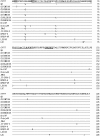Molecular characterization and phylogenetic analysis of membrane protein genes of porcine epidemic diarrhea virus isolates in China
- PMID: 18214664
- PMCID: PMC7088904
- DOI: 10.1007/s11262-007-0196-7
Molecular characterization and phylogenetic analysis of membrane protein genes of porcine epidemic diarrhea virus isolates in China
Abstract
Six porcine epidemic diarrhea viruses (PEDVs) were isolated from the fecal samples of piglets infected with PEDV in 2006 in China. The membrane (M) protein genes of six PEDV isolates were amplified by reverse transcriptase-polymerase chain reaction (RT-PCR), then cloned, sequenced, and compared with each other as well as those ten PEDV reference strains. The M protein genes of six Chinese PEDV isolates consisted of 692 nucleotides containing a single open reading frame (ORF) of 681 nucleotides, which encoded a 226aa-long peptide. The conserved intergenic motif (ATAAAC), as previously recognized in Br1/87, was found in the 5 nucleotides upstream of the initiator ATG of M protein genes of six Chinese PEDV isolates. The hexamer motif was also found in CV777, JMe2, LZC, and QH. The M protein of six isolates had three main transmembrane domains (aa20-38, aa43-65, aa75-97). The M protein of one isolate, CH/IMT/06, had one potential glycosylation site, but those of the other five isolates had two. The glycosylation sequence Asn-Phe-Thr was highly conserved in the M proteins of six PEDV isolates. The six PEDV isolates showed nucleotide sequence homology between 98.8 and 100% and deduced amino acid sequence homology between 98.2 and 100% with each other. The nucleotide and amino acid identity of M protein genes between the six PEDV isolates and ten reference PEDV strains varied from 97.2 to 99.4% and 96.9 to 100%, respectively. On the basis of the phylogenetic relationship of M protein genes, six Chinese PEDV isolates composed of a separate cluster including one Chinese strain JS-2004-02, however, not including the Chinese strain LJB/03. These results demonstrated that there was a new genotype of PEDV prevailing in China.
Figures





References
-
- J. Oldham, Pig Farming (Oct suppl), 72–73 (1972)
-
- M.B. Pensaert, S.G. Yeo, in Disease of Swine, ed. by B.E. Straw, J.J. Zimmerman, S. D’Allaire, D.J. Taylor (The Blackwell Publishing Professional, Ames, IA, 2006), pp. 367–372
-
- Qinghua C., Xiaoying N., Chengyu Y. J. Anim. Vet. Sci. 1992;22(3):22 .
-
- de Bouck P., Pensaert M.B. Am. J. Vet. Res. 1980;41:219–223. - PubMed
Publication types
MeSH terms
Substances
LinkOut - more resources
Full Text Sources
Other Literature Sources

